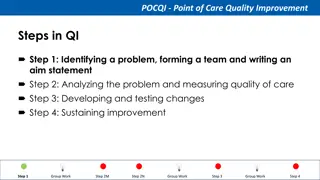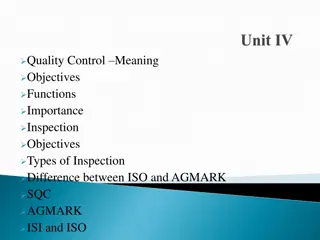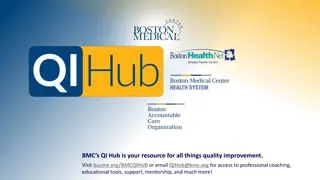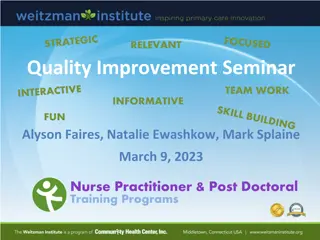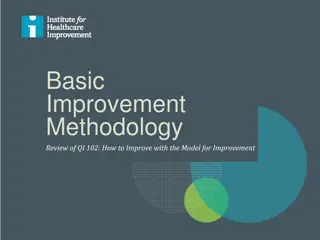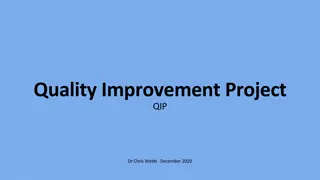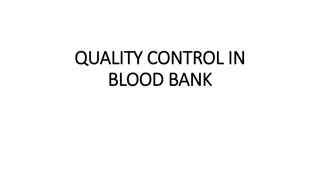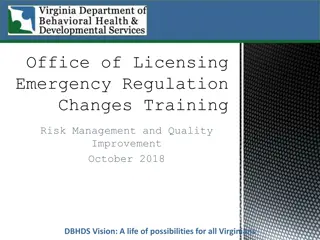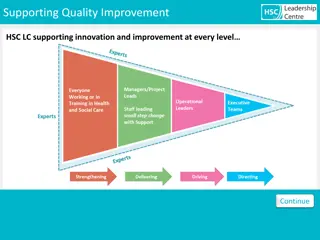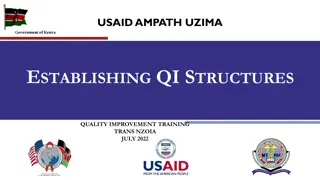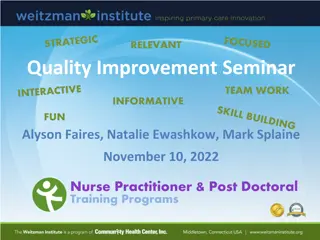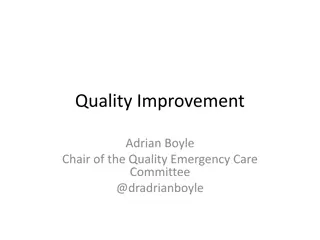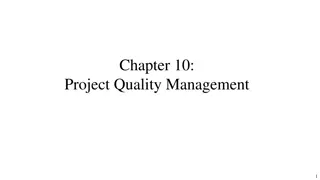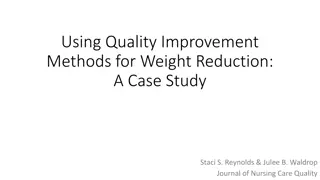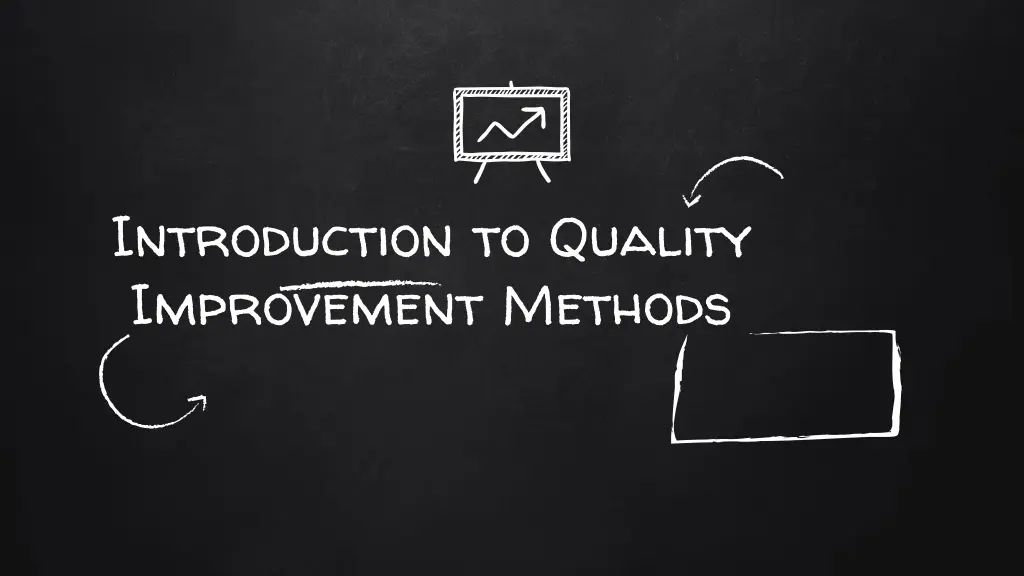
Understanding Quality Improvement Methods in Healthcare
Explore the principles and methods of quality improvement in healthcare, including problem identification, measurement, intervention development, and testing. Learn about the science of improvement, types of measures, and tools for interpreting data such as bar charts and pie charts.
Download Presentation

Please find below an Image/Link to download the presentation.
The content on the website is provided AS IS for your information and personal use only. It may not be sold, licensed, or shared on other websites without obtaining consent from the author. If you encounter any issues during the download, it is possible that the publisher has removed the file from their server.
You are allowed to download the files provided on this website for personal or commercial use, subject to the condition that they are used lawfully. All files are the property of their respective owners.
The content on the website is provided AS IS for your information and personal use only. It may not be sold, licensed, or shared on other websites without obtaining consent from the author.
E N D
Presentation Transcript
Introduction to Quality Improvement Methods
Learning objective Learning objective o To describe the principles of quality improvement. o To introduce the basic methods and tools for improving the quality of health care. o To understand the benefits of using quality improvement methods. o To apply the principles and use the tools to undertake their own improvement project. 2
The purpose of Quality improvement methods The purpose of Quality improvement methods Identify a problem; Measure the problem; Develop a range of interventions designed to fix the problem; Test whether the interventions worked
The science of improvement The science of improvement The r ole of measur ement in impr ovement The r ole of measur ement in impr ovement Measurement (collect and analyze data )is an essential component of quality Improvement. There is strong evidence to show that when people use the appropriate measures to measure change, significant improvements can be made. All quality improvement methods rely on measurement
The science of improvement The science of improvement Three main types of measures Structure Measures: Measures of infrastructures, capacity and system Example: Nursing to patient ratio in the ICU Processes Measures:. They measure if parts of steps in the system are performing as planned Example: Bed occupancy rate Outcomes Measures Are results of overall process or system performance , reflect the impact of the health care service Example: The 30-day mortality rate
Picturing the Data Picturing the Data There are many valuable tools for interpreting and presenting data eg. pie chart, bar chart ,line chart Type of gr aph : Type of gr aph : 1. 1. Bar char t Bar char t 2. 2. Pie char t Pie char t 3. 3. Line char t Line char t
Bar chart Bar chart Bar charts are one of the most commonly used types of graph. The bar chart displays data using a number of bars, each representing a particular category useful for looking at a set of data and making comparisons
Pie chart Pie chart A pie chart is a circular graph that shows the relative contribution that different categories contribute to an overall total.
Line chart Line chart A line graph, also known as a line chart, is a type of chart used to visualize the value of something over time
Performance Improvement methods FOCUS PDCA RCA QIP BRAIN STORMING
improvement model- (Plan Plan- -do do- -study study- -act cycle) act cycle) The IHI model has two parts: Three fundamental questions, which can be addressed in any order The PDSA cycle to test and implement changes in real work settings the PDSA cycle guides the test of a change to determine if the change is an improvement.
PDSA Plan: Define the problem to be addressed, collect relevant data, and ascertain the problem's root cause. Do: Develop and implement a solution; decide upon a measurement to gauge its effectiveness. Study: Confirm the results through before-and-after data comparison. Act: Document the results, inform others about process changes, and make recommendations for the problem to be addressed in the next PDCA cycle.
improvement model-(Plan Plan- -do do- -study study- -act cycle) act cycle) 13
Root cause analysis (RCA) Root cause analysis (RCA) ( (ishikawa ishikawa/fishbone) /fishbone) Is a def ined pr ocess t hat seeks Is a def ined pr ocess t hat seeks t o explor e all of t he possible f act or s associat ed wit h an incident possible f act or s associat ed wit h an incident by asking what happened, why it occur r ed and what can asking what happened, why it occur r ed and what can be done t o pr event it f r om happening again. be done t o pr event it f r om happening again. t o explor e all of t he by A tool for solving problems. The diagram is used to explore and display the possible causes of a certain effect
An effective root cause analysis requires the following An effective root cause analysis requires the following components components The team develops a problem statement Multidisciplin ary team 16
Root cause analysis effort is directed towards finding out what happened Documentation and review (medical records, incident forms, hospitals guidelines, literature review Site visit to examine the equipment, the surroundings and observe the relationships of the relevant staff 17
improvement improvement model model- - Root Root cause cause analysis analysis (RCA) (RCA) Est ablishing t he cont r ibut ing f act or s or r oot causes ar e accomplished t hr ough Est ablishing t he cont r ibut ing f act or s or r oot causes ar e accomplished t hr ough A br ainst or ming pr ocess of all possible f act or s: A br ainst or ming pr ocess of all possible f act or s: Envir onment al f act or s Envir onment al f act or s: : e.g. The work environment; medico-legal issues Or ganizat ional f act or s: Or ganizat ional f act or s: e.g. Staffing levels; policies; workload and fatigue T Team st af f f act or s: eam st af f f act or s: e. e.g. Supervision of junior staff; availability of senior doctors Individual st af f f act or s: Individual st af f f act or s: e.g. Level of knowledge or experience Task f act or s: Task f act or s: e.g. Existence of clear protocols and guidelines Pat ient f act or s: Pat ient f act or s: e.g. Distressed patients; communication and cultural barriers between patients and staff; multiple co-morbidities.
QUALITY IMPROVEMENT PLAN (QIP) A Quality Improvement Plan is a detailed work plan intended to enhance an organization s quality in a specific area Quality Improvement Plan includes essential information about how your organization will design, implement, manage, and assess quality.
Brain storming Brain storming Brainstorming is a technique by which a group attempts to find a solution(s) to a specific problem by amassing ideas spontaneously It is a highly effective technique for maximizing group creative potential
thanks! Any questions? 22

